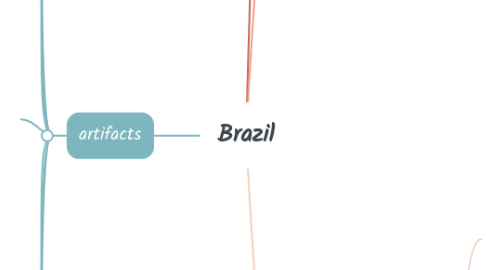
1. artifacts
1.1. Muriaquita
1.1.1. The muriaquita, a carved green frog shaped stone, was used as an amulet by the tapajos women to prevent disease and avoid infertility.
1.2. The venus figurines
1.2.1. the venus figurines are stattues depicting obese women that up untill now, were thought to have been assocciated with fertility and beauty. they may have served a ritual or symbolic function.
1.3. the loin cloth
1.3.1. the lion cloth is a piece of cloth somtimes worn by men in order to cover their somthing, especially in countrys when its too hot to wear anything else.
1.4. Christ the Redeemer
1.4.1. It is believed that their is one God that is the most powerful being in the universe. It was in honor for princess Isabel for freeing the slaves, and she asked for the statue to be the Sacred Heart of Jesus. Most Brazilians believe in The Roman Catholic Church. It ia located in Rio de Janeiro Corcovado Brazil. The Christ the Redeemer Statue has become a symbolic protector of people.
1.5. Brazillian Straw basket
1.5.1. It is an art form which often combines both utilitarian and aesthetic qualities. Baskets are made for a variety of purposes, including food gathering and storage, furnishings, garments and ceremonial uses. Basketry can transmit important artistic knowledge and cultural traditions.
1.6. Brazilian Flag
1.6.1. It was made when the brazilians declared freedom. It was to show their independence. The different colors have different meanings and the 27 stars mean the 26 states and 1 federalism and green means the rainforests. There were actually 2 flags made, first - 1889 new one 1992. The new flag means order and progress
1.7. Golden trumpet flower
1.7.1. Trumpet flower is an ornamental shrub or small tree native to Mexico and other parts of Latin America, but is now found growing throughout India, as well. Allamanda cathartica, commonly called golden trumpet, common trumpetvine, and yellow allamanda, is a species of flowering plant of the genus Allamanda in the Apocynaceae (Dogbane family). The plant is a vigorous, rambling woody climber that can get up to 15 feet tall although it can be pruned to grow as a shrub with a more compact shape, especially when grown in a container. IT IS used for an antidote for poisoning.
1.8. THE coat and arms of brazil
1.8.1. it was made to represent they became a rebpublic and to symbolize that they love coffee
2. Group mates: Seth, Juaquin, Susu, Andrew
3. Rituals
3.1. Easter
3.1.1. They do Easter because to celebrate the Holy Week and the death and resurrection of Jesus Christ . They value Easter because of the prophecies of the Old Testament and the revelation of gods salvific plan for all human kind. Easter is important to Brazilians because Brazilians go to mass to give thanks to God and they give Easter eggs to one another.
3.2. Christmas
3.2.1. 54% of Brazilians are Catholic, but some aren't and they celebrate Christmas because it's a pleasant occasion with delicious food. Christmas symbolizes the birth of Jesus.
3.3. India Day
3.3.1. That is because this special date was created in the first Inter-American Indian Congress. That congress was a reunion of Native American representatives from all over the continent.
3.4. Samba
3.4.1. The samba is considered the dance of celebration and joy at Carnival celebrations in Brazil. Its combination of heterogeneous musical and cultural diversity of the country it self.
3.5. Capoeira
3.5.1. Maintain respect for ourselves, each other, our ever-evolving capoeira community, the studio we share, and the art that we practice together. Freedom: Create a safe space to express ourselves as unique individuals. Equality: Acknowledge everyone's contribution as valuable.
4. Traditions
4.1. Carnivals -
4.1.1. They all host carnivals known the world over as celebrations of tradition through dances, music and dazzling costumes. But beyond their draw as multi-sensorial cultural displays, they also serve economic drivers and community builders, a potential that is leading an increasing number of government institutions and policymakers to consider and foster the many ways in which carnivals can improve lives in Latin America and the Caribbean.
4.2. Christmas
4.2.1. 54% of Brazilians are Catholic, but some aren't and they celebrate Christmas because it's a pleasant occasion with delicious food. Christmas symbolizes the birth of Jesus.
4.3. India Day
4.3.1. they celebrate india day because this special date was created in the first Inter-American Indian Congress. That congress was a reunion of Native American representatives from all over the continent.
4.4. Festa de lemanja
4.4.1. They do festa de lemanja because lemanja is a motherly goddess who can cure and cleanse and they do festa de lemanja because lemanja governs healing , protection and fertility for women. They value lemanja because she is a goddess that helps women. Festa de lemanja is important to Brazilians because she is the protecter of the river and she helps women
4.5. Feijoada on a Tuesday
4.5.1. Feijoada on a Tuesday is Brazilians eating feijoada. Feijoada is typically eaten at the weekend with a family or a group of friends over an extended lunch period. It's considerd a cofort food and is oftefn
4.6. Samba
4.6.1. The samba is considered the dance of celebration and joy at Carnival celebrations in Brazil. Its combination of heterogeneous musical and cultural diversity of the country it self.
